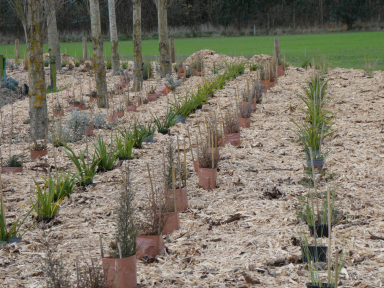Landscaping Wastewater Drainage Fields

Whether you have just installed a new septic drain field (or effluent disposal field) on your property or bought a property with an existing one, it can be challenging to know what to do with the space and soil above the system.
There are several reasons why a homeowner may wish to landscape over their septic tank drain field. One is that covering the area with certain types of plants can help the system work more effectively by absorbing excess moisture, which would place less strain on the system. Some plant root systems can also help prevent soil erosion from heavy rainfall that could harm the septic tank’s functionality.
You will likely want to landscape over your drain field for aesthetic reasons. An existing septic drain field may be in a sunny or prominent spot on your property that you want to look nice. Plants can make the area look lush and inviting and hide away the functionality of the space.
Planting on your wastewater disposal field can limit the growth of unwanted plants and help optimise your system’s performance. Plants soak up effluent or wastewater in the soil and release it in the air in the form of vapour. The plants reduce reliance on the soil to absorb effluent by maximising water loss.
Plants also help the environment by absorbing the effluent and preventing it from making its way into stream systems or underground water tables. We provide a sample list of plants suitable for disposal fields but as a general rule, do not choose deep-rooting plants as they can damage your system.
Plants Recommended for Effluent Disposal Fields
The two main reasons for putting plants on effluent fields are:
- To soak up the wastewater and transpire (the plants version of perspiring) it out through the plants foliage.
- To absorb nutrients out of the wastewater so that it does not make its way into the underground water table and so on into stream systems.
Thus, plants that have a high transpiration rate, vigorous growth and are tolerant of wet soil conditions are best. Plant spacings will vary depending upon species and mature size, but it’s generally calculated at 1 plant per square metre of field. Thus a 200m square field should have 200 plants and so-on. When planting smaller grasses or lilies you may space them at 50-75cm while medium sized trees may be spaced at 1.2-1.5m, so overall with a mixed species planting it is typically 1 plant per metre.
The key differences between the two common types of effluent fields are:
- Underground pipes (usually 100mm diameter pipes with small seepage holes along its length and buried 600mm underground).
- Dripper lines on the ground surface (usually 15mm diameter hoses with drippers laid under mulch).
The biggest concern for the fields with underground pipes is the possibility of damage from large tree roots or blockage of the seepage holes along the pipes. Blockage is most likely to happen with deep rooting trees, or trees that will put out masses of feeder roots into water. To arrange a site visit to discuss planting solution contact our field expert Sue McGaw.

Hours
Open 7 days a week: 10am-4pm